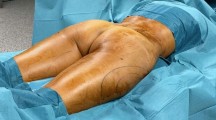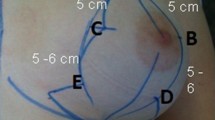Abstract
Introduction
Mastopexy in combination with implant breast augmentation still remains a controversial topic in plastic surgery because of its complexity and its relative high rate of complications. To obviate the need of a breast implant, numerous authors described glandular rearrangement techniques to optimize upper pole fullness and breast projection. More recently, the combination of mastopexy and lipofilling has been described. The aim of this study is to report our experience on one-stage mastopexy–lipofilling in cosmetic breast surgery, describing our surgical technique and focusing on long-term esthetic results and patient-reported outcomes.
Material and Method
A prospective observational study was performed including all patients underwent cosmetic one-stage mastopexy–lipofilling. Collected data included patient’s age and BMI, smoking, preoperative and postoperative cup size and grade of ptosis, preoperative and postoperative distances between the upper part of the nipple areola complex and the inframammary fold and between the upper part of the nipple areola complex and the sternal notch, mean liposuction and fat injection volume, mean operating time and postoperative complications. Cosmetic results and patient satisfaction were evaluated using the 5 points Likert scale considering breast volume, shape, symmetry, quality of scars, nipple areola complex and donor site shape and global satisfaction.
Results
A total of 21 patients (42 breasts) were included with a mean follow-up of 13.8 months. Mean liposuction and injection volumes were 1070 mL and 230 mL, respectively. With respect to breast size, 11 patients (52.4%) showed an increase in one-cup size, while 10 patients (47.6%) showed a slight increase in volume without changing cup size. The mean NAC-SN and NAC-IMF distances decreased by an average of 3.7 cm and 1.7 cm, respectively. Regarding esthetic outcomes, the mean scores for breast volume, shape, symmetry, quality of scars, nipple areola complex and donor site shape were 4.1, 4.2, 4.9, 4, 4.6 and 5, respectively. With respect to patient satisfaction, mean scores for breast volume, shape, symmetry, quality of scars, nipple areola complex and donor site shape were 4.2, 5, 5, 4.7, 5 and 5, respectively. The achievement of a satisfactory outcome (> 4) was obtained in all patients but 1 with a mean score of 4.5 (3–5).
Conclusion
The current study suggests that one-stage mastopexy–lipofilling is a safe technique, which leads with satisfactory outcomes allowing breast contouring and breast volume increase.
Level of Evidence IV
This journal requires that authors assign a level of evidence to each article. For a full description of these Evidence-Based Medicine ratings, please refer to the Table of Contents or the online Instructions to Authors www.springer.com/00266.








Similar content being viewed by others
References
Rinker B, Veneracion M, Walsh CP (2010) Breast ptosis: causes and cure. Ann Plast Surg 64(5):579–584
American Society of Aesthetic Plastic Surgeons 2018 Cosmetic Surgery National Data Bank. New York, NY: ASAPS Communications Office
Regnault P (1976) Breast ptosis. Definition and treatment. Clin Plast Surg 3(2):193–203
Spring MA, Hartmann EC, Stevens WG (2015) Strategies and challenges in simultaneous augmentation mastopexy. Clin Plast Surg 42(4):505–518 (Epub 2015 Aug 25)
Hall-Findlay EJ (2002) Pedicles in vertical breast reduction and mastopexy. Clin Plast Surg 29:379–391
Gonzalez-Ulloa M (1960) Correction of hypertrophy of the breast by exogenous material. Plast Reconstr Surg 25:15–26
Regnault P (1966) The hypoplastic and ptotic breast: a combined operation with prosthetic augmentation. Plast Reconstr Surg 37:31
Nahai F, Fisher J, Maxwell PG et al (2007) Augmentation mastopexy: to stage or not. Aesthet Surg J 27:297–305
Scott LS, Gerald HP, Sharon YG (2000) Simultaneous breast augmentation and mastopexy. Aesthet Surg J 20(2):155–164
Karnes J, Morrison W, Salisbury M et al (2000) Simultaneous breast augmentation and lift. Aesthet Plast Surg 24:148–154
Gryskiewicz J (2012) Dual-plane breast augmentation for minimal ptosis pseudoptosis (the “in-between” patient). Aesthet Surg J 33:43–65 (6)
Elliott LF (2002) Circumareolar mastopexy with augmentation. Clin Plast Surg 29:337–347 (2003;27:13–9)
Ramirez OM (2002) Reduction mammaplasty with the “owl” incision and no undermining. Plast Reconstr Surg 109:512–524
Barutcu A, Baytekin C (2009) One-stage augmentationmastopexy with wise pattern and inverted-T scar. Aesthetic Plast Surg 33:784–785 (17)
Persoff MM (2003) Vertical mastopexy with expansion augmentation. Aesthet Plast Surg 27:13–19
Stevens WG, Stoker DA, Freeman ME et al (2006) Is onestage breast augmentation with mastopexy safe and effective? A review of 186 primary cases. Aesthet Surg J 26:674–681
Khavanin N, Jordan SW, Rambachan A, Kim JY (2014) A systematic review of single-stage augmentation-mastopexy. Plast Reconstr Surg 134(5):922–931
Honig JF, Frey HP, Hasse FM, Hasselberg J (2009) Autoaugmentation mastopexy with an inferior-based pedicle. Aesthet Plast Surg 33:302–307
De la Plaza R, Cruz L, Moreno C (2005) Mastopexy utilizing a dermoglandular hammock flap. Aesthetic Surg J 25:31–36
Eisenberg T (2012) Simultaneous augmentation mastopexy: a technique for maximum en bloc skin resection using the inverted-T pattern regardless of implant size, asymmetry, or ptosis. Aesthet Plast Surg 36:349–354
Parsa AA, Jackowe DJ, Parsa FD (2010) A new algorithm for breast mastopexy/augmentation. Plast Reconstr Surg 125:75e–77e
Ceydeli A, Freund RM (2003) Tear-drop augmentation mastopexy: a technique to augment superior pole hollow. Aesthet Plast Surg 27:425–32; discussion 433
De Fazio D, Cingozoglu CAC (2020) Combined mastopexy and augmentation with autologous fat grafting: first results with lipopexy. Plast Reconstr Surg Glob Open 8(2):e1957
Raafat SS, Ezzat SZ, Khachaba YA, Aboul-Nasr LA (2020) Autologous mastopexy and autoaugmention of the breast. Plast Reconstr Surg Glob Open 8(10):e3126
Khouri RK, Eisenmann-Klein M, Cardoso E et al (2012) Brava and autologous fat transfer is a safe and effective breast augmentation alternative: results of a 6-year, 81-patient, prospective multicenter study. Plast Reconstr Surg 129:1173–1187
Khouri RK, Rigotti G, Cardoso E et al (2014) Megavolume autologous fat transfer: part I. Theory and principles. Plast Reconstr Surg 133:550–557
Rigotti G (2013) Discussion: the volumetric analysis of fat graft survival in breast reconstruction. Plast Reconstr Surg 131:192–193
Groen JW, Negenborn VL, Twisk JW, Ket JC, Mullender MG, Smit JM (2016) Autologous fat grafting in cosmetic breast augmentation: a systematic review on radiological safety, complications, volume retention, and patient/surgeon satisfaction. Aesthet Surg J 36(9):993–1007
Mallucci P, Branford OA (2014) Population analysis of the perfect breast: a morphometric analysis. Plast Reconstr Surg 134(3):436–447
Abboud MH, Dibo SA (2015) Immediate large-volume grafting of autologous fat to the breast following implant removal. Aesthet Surg J 35(7):819–829
Zheng DN, Li QF, Lei H et al (2008) Autologous fat grafting to the breast for cosmetic enhancement: experience in 66 patients with long-term follow up. J Plast Reconstr Aesthet Surg 61:792–798
Groen JW, Piatkowski AA, Sawor JH, Wilschut JA, Ritt MJPF, van der Hulst RRJW (2018) European survey study among plastic/breast surgeons on the use of and opinion toward autologous fat transfer: with emphasis on breast surgery. Surg Innov 25(6):602–615 (Epub 2018 Sep 24)
Ørholt M, Larsen A, Hemmingsen MN, Mirian C, Zocchi ML, Vester-Glowinski PV, Herly M (2020) Complications after breast augmentation with fat grafting: a systematic review. Plast Reconstr Surg 145(3):530e–537e
Qureshi AA, Myckatyn TM, Tenenbaum MM (2018) Mastopexy and mastopexy–augmentation. Aesthet Surg J 38(4):374–384
Walters J, Bourn L, Tessler O, Patterson C, Khoobehi K (2020) Single staged mastopexy with autologous fat grafting: an alternative to augmentation mastopexy with implants. Aesthet Surg J 40(4):NP152–NP158
Spear SL, Pelletiere CV, Menon N (2004) One-stage augmentation combined with mastopexy: aesthetic results and patient satisfaction. Aesthet Plast Surg 28:259–267
Funding
This research did not receive any specific grant from funding agencies in the public, commercial, or not-for-profit sectors.
Author information
Authors and Affiliations
Corresponding author
Ethics declarations
Conflict of interest
The authors have no conflicts of interest to disclose.
Human or Animal Rights
This article does not contain any studies with human participants or animals performed by any of the authors.
Informed Consent
For this type of study, informed consent is not required.
Additional information
Publisher's Note
Springer Nature remains neutral with regard to jurisdictional claims in published maps and institutional affiliations.
Rights and permissions
About this article
Cite this article
Mangialardi, M.L., Ozil, C. & Lepage, C. One-Stage Mastopexy–Lipofilling in Cosmetic Breast Surgery: A Prospective Study. Aesth Plast Surg 45, 1975–1985 (2021). https://doi.org/10.1007/s00266-021-02327-y
Received:
Accepted:
Published:
Issue Date:
DOI: https://doi.org/10.1007/s00266-021-02327-y




